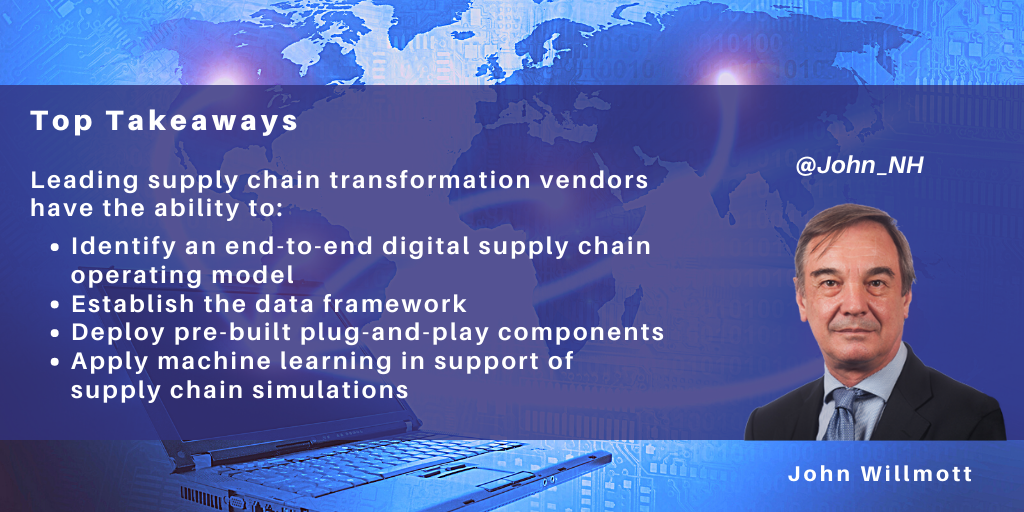posted on Aug 30, 2022 by John Willmott

The pandemic stress-tested many supply chains beyond previous expectations, identifying and magnifying any process shortfalls. The current economic downturn and additional disruption of supply chains by geopolitical factors have further exacerbated the difficulties enterprises face in their day-to-day supply chain management.
Accordingly, enterprises are typically seeking increased digitalization and efficiency in their supply chains, greater supply chain agility, and much, much better supply chain visibility.
However, organizations are typically not self-sufficient in driving supply chain transformation and look for partners to assist them in this journey.
So, what should organizations look for in a supply chain transformation partner?
Ability to Identify End-to-End Digital Supply Chain Operating Model
Larger organizations will be looking not just for a service provider but for a trusted advisor who can proactively deliver innovation and best practices. This typically entails finding a supply chain vendor to work with them using design thinking to identify their new target operating model that can achieve the key business outcomes sought. Such vendors typically have innovation labs where they bring domain consultants and technology experts to co-create with client executives. As well as innovation expertise, the vendor should bring its own benchmarks to measure the client’s current performance and assist in establishing target KPIs within the to-be operating model and understand the best practice processes that are key to achieving these desired KPIs and business outcomes. This level of process knowledge typically comes from operational process expertise obtained through many years of running and enhancing client supply chain processes. Hence, it is important to choose a vendor with both consulting and operational supply chain expertise to reimagine and deliver supply chain transformation.
End-to-end supply chain expertise is also becoming increasingly important. Supply chain transformation requires an ability to break down existing silos and integrate data and automation across silos, so vendors need to be able to design and implement an end-to-end operating model reaching from demand identification and planning & supply planning through order fulfillment and transport planning & optimization, to warranty & returns operations. Indeed, manufacturing optimization could even be included as part of the end-to-end supply chain view for a more enterprise-wide perspective of the supply chain. This holistic perspective is necessary to eliminate friction between departments and automate transactional activities to the extent possible.
Ability to Establish the Data Framework
Data is an immensely important part of this perspective. The existence of supply chain silos within organizations has often resulted in multiple data sources that are fragmented and potentially inconsistent and out-of-date. In the new supply chain operating model, the vendor must incorporate real-time data quality and consistency into the design to provide a solid data analytics and visualization framework. Accordingly, the new operating model should have strong master data management holding a single version of the truth. This will typically require the vendor to undertake ERP standardization and optimization, including improving existing ERPs' controls and implementing a data lake. It will probably also involve improving the level of integration downstream with distributors and customers, upstream with raw material and component suppliers, and within the supply chain itself, e.g., with logistics firms.
It may even be appropriate to undertake cloud migration of existing ERPs.
Ability to Deploy Pre-Built Plug-and-Play Components
The vendor should provide a comprehensive integration platform, control towers, and dashboards within the new supply chain operating model. This integration platform will typically access a wide range of pre-developed plug-and-play models. These plug-and-play models will be based on both proprietary tools and platforms and have the ability to seamlessly integrate specialist point platforms for areas such as transportation planning and inventory management.
While they are likely to have preferred partners for many of the point solutions required, the vendor should have a broad alliance ecosystem with pre-built APIs and supply chain integration and build in longevity to the digital supply chain operating model by providing the ability to switch platforms in and out within its integration framework as new platforms and opportunities become available. These platforms, whether proprietary or third-party, will predominantly be cloud-based to provide greater supply chain scalability and resilience.
Ability to Apply Machine Learning in Support of Supply Chain Simulations
Enhanced demand forecasting is currently a key component of supply chain transformation. Depending on the type of business, the vendor should be able to integrate customer data from point-of-sale, social platforms, and third-party data sources, ingest data from the organization's systems and apply this data within pre-built machine learning models. Machine learning models should be used to improve forecasting accuracy and to run simulations, for example, to indicate the impact of marketing campaigns and price adjustments.
However, machine learning and analytics have a much wider role in underpinning simulations across the supply chain, including in supply forecasting and logistics optimization. In addition, digital twins are starting to be deployed to test and refine transformational approaches before their adoption, while process mining should be used to check process conformance and further opportunities for process automation.
Summary
In summary, leading supply chain vendors will possess:
- A combination of consulting, technology, and operations expertise in supply chain management supported by design thinking labs
- Best-practice supply chain solutions based on integrated combinations of process models, industry platforms, and automation technologies
- A supply chain integration platform and a pre-built portfolio of supply chain plug-and-play models for process automation
- A strong alliance ecosystem for access to best-in-class supply chain tools and platforms
- The ability to think end-to-end, breaking down supply chain silos and automating transactional activities across the supply chain
- Dedicated supply chain talent with specialized skills and capabilities
- Predictive and cognitive supply chain capabilities, including strong forecasting and digital twin capability.
